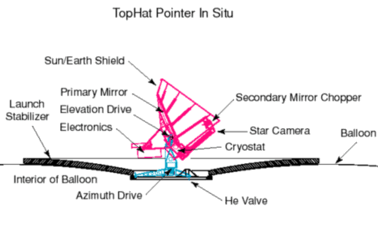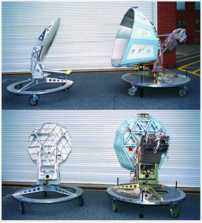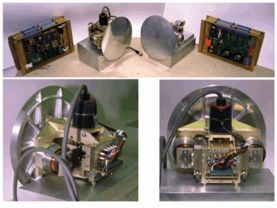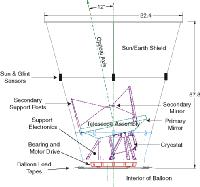To
take advantage of new opportunities for long-duration circumpolar
ballooning (LDB), we have developed a novel instrument concept:
TopHat. Designed to provide reliable, quantitative measurements
of the CMBR anisotropy, TopHat is optimized to reject both
systematic and foreground spurious signals. We achieve this
by placing the telescope on top of the balloon, creating
an observing environment unequaled in any sub-orbital CMBR
experiment performed to date. By mounting the telescope
on top of the balloon, the entire sky above the instrument
will be free from supporting structures which could scatter
radiation into the sidelobes of the optics---a critical
source of systematic uncertainty for anisotropy measurements
at the 10-6 level of sensitivity. Two versions
of TopHat are being constructed: the Pointer and the Spinner.
The TopHat Pointer is similar to MSAM both in the Cassegrain
style of the telescope and its ability to perform pointed
integrations. The beam size makes this instrument sensitive
to angular scales as fine as 0.33 degrees. The TopHat Pointer
will be able to observe the same region of sky as MSAM2
with similar sensitivity except at shorter wavelengths.
This will provide unprecedented spectral coverage of a significant
portion of the sky. Not only does this yield an excellent
check of systematic errors which can plague any experiment
of this sensitivity, it also will enable us to understand
the nature of the far-infrared foreground spectrum in high
galactic latitudes as never before. We originally planned
to fly this experiment from mid-latitudes in 1998. Following
the recommendations of an independent scientific review,
we have deferred this flight in order to advance the schedule
for the TopHat Spinner.

This
illustration shows the main components of the
TopHat Pointer. All the components in this picture
are on top of the balloon.
|

This
picture shows the engineering test package (ETP) for the
TopHat Pointer (right) and the hardware for the actual
scientific flight payload (left). The ETP is a fully functional
unit with mockup optical components, and was intended
to be flown in a test flight. We have now deferred development
of the TopHat Pointer in favor of the TopHat Spinner.
The TopHat Spinner will map a 48 degree diameter disk
of sky above the Southern Polar Cap at 20 arcminute resolution.
To accomplish this, the telescope, tipped 12 degrees off
the zenith, simply spins at a constant rate about the
vertical axis. Each rotation sweeps out a circle of 24
degrees. As the Earth rotates, the entire polar cap is
observed each day. The TopHat Spinner will be launched
from Antarctica as a Long Duration Balloon (LDB) flight
and will have approximately 2 weeks of observation time.
This will permit a substantial fraction of the flight
to be dedicated to studying and characterizing systematics
in-flight while still maintaining high sensitivity to
CMBR anisotropy. Observing in five spectral bands between
5 and 21 icm (150 and 630 GHz, 0.5 to 2.0 mm) with anisotropy
sensitivity on 0.33 to 48 degree angular scales, a single
TopHat Spinner flight is expected to measure over 1800
square degrees of sky and about 20000 independent points.

This
picture shows the chopper mechanism, electronics,
and secondary mirror for the TopHat Pointer
|

This
illustration shows the main components of the
TopHat Spinner. All components in this picture
are on top of the balloon.
|
The TopHat Spinner will be launched from Antarctica
in late 1999. We are testing the components in a series
of test flights in 1998.
This
integrated program reflects a central lesson underscored
by the COBE/DMR experience---that extremely careful understanding
of systematic errors and foreground sources, and not simply
raw detector sensitivity, is the key to any unequivocal
measurement of the CMBR anisotropy.
The
measurement of CMBR anisotropy is a very active field,
with many experiments, current and planned, that are providing
clues to solve this important puzzle. For more information
on these experiments, please (view this excellent summary
http://www.sns.ias.edu).